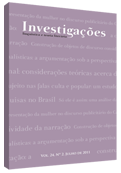Construção de objetos de discurso: considerações em casos que o referente é um ator da vida social
Abstract
Analisamos diferentes estratégias referenciais utilizadas pelo locutor para construção da argumentação no texto: casos de construção de objetos de discurso quando o referente é um ator da vida social, em textos jornalísticos. Baseamo-nos na concepção de instabilidade constitutiva dos discursos (Mondada e Dubois 2003 [1995]) e nas diferentes estratégias de evolução dos referentes na cadeia textual (Apothéloz & Reichler-Béguelin 1995).References
ALVES FILHO, F. 2010. “Sua casinha é meu palácio”: por uma concepção dialógica de Referenciação. Linguagem em (Dis)curso 10(1): 207-226.
APOTHÉLOZ & REICHLER-BÉGUELIN, M. J. 1995. Construcion de la référence et stratégies de designation. In: A. Berrendonner & M. J. Reichler-Béguelin (Eds.). Du sintagme nominal aux objets-de-discours: SN complexes, nominalisations, anaphors. Institute de Linguistique; Université de Neuchâtel. Suisse: (TRANEL), n°23, pp. 227-271.
KOCH, I. G. V. 2008. A produção de inferências e sua contribuição na construção de sentido. In: As tramas do texto. São Paulo: Nova Fronteira, pp. 135-140.
MAINGUENEAU, D. 2008 [1998]. Tipos de Designações In: Análise de textos de comunicação. São Paulo: Cortez, pp. 179-193.
MONDADA & DUBOIS, D. 2003. Construção dos objetos de discurso e categorização: uma abordagem dos processos de referenciação. In: Mônica M. Cavalcante; Bernardete B. Rodrigues; Alena Ciulla (Eds.). Referenciação. São Paulo: Contexto, pp. 17-52.
VIEIRA, M. L. 2010. Construção de objetos de discurso em cadeias textuais: a inter-relação entre expressão referencial e predicação. Dissertação de Mestrado. Universidade Federal do Piauí: Teresina.
Downloads
Published
How to Cite
Issue
Section
License
Copyright (c) 2011 Francisco Alves Filho, Maria Lourdilene Vieira

This work is licensed under a Creative Commons Attribution 4.0 International License.
Authors who publish with Revista Investigações agree to the following terms:
Authors retain copyright and grant the journal right of first publication with the work simultaneously licensed under the Creative Commons Attribution 4.0 International (CC BY 4.0) license that allows others to share the work with an acknowledgement of the work's authorship and initial publication in this journal.
Authors are able to enter into separate, additional contractual arrangements for the non-exclusive distribution of the journal's published version of the work (e.g., post it to an institutional repository or publish it in a book), with an acknowledgement of its initial publication in this journal.
You are free to:
Share — copy and redistribute the material in any medium or format for any purpose, even commercially.
Adapt — remix, transform, and build upon the material for any purpose, even commercially.
The licensor cannot revoke these freedoms as long as you follow the license terms.
Under the following terms:
Attribution — You must give appropriate credit , provide a link to the license, and indicate if changes were made . You may do so in any reasonable manner, but not in any way that suggests the licensor endorses you or your use.
No additional restrictions — You may not apply legal terms or technological measures that legally restrict others from doing anything the license permits.

